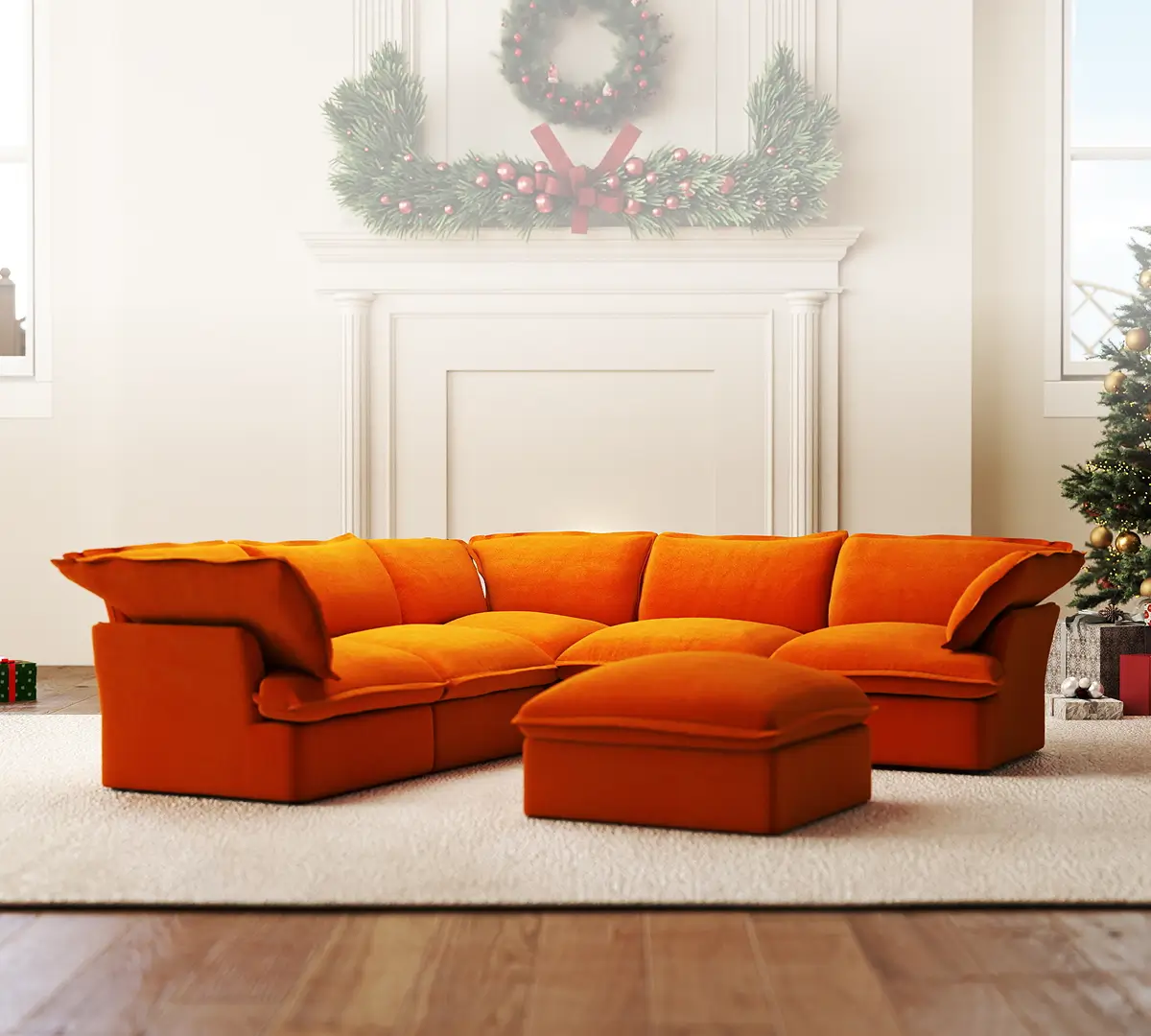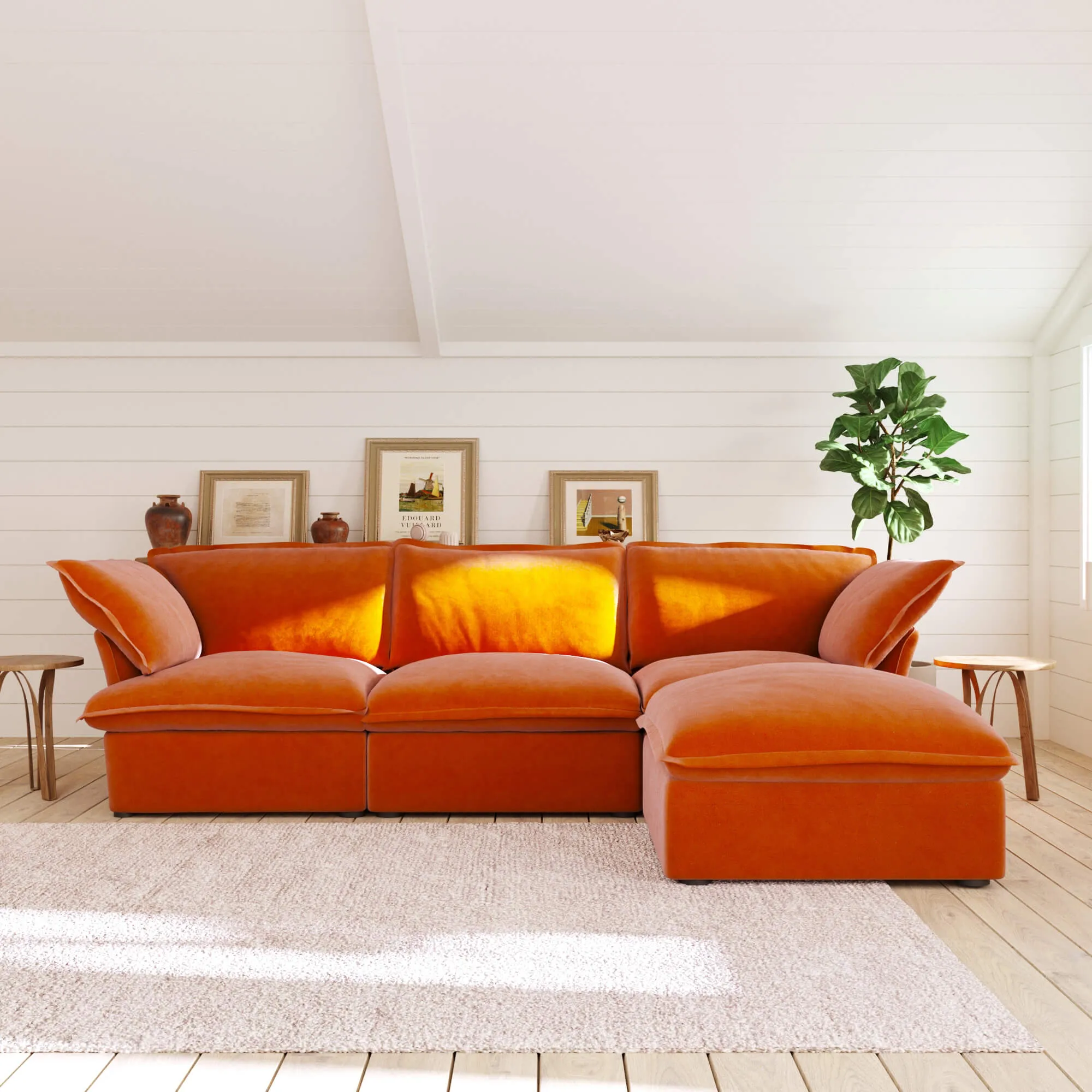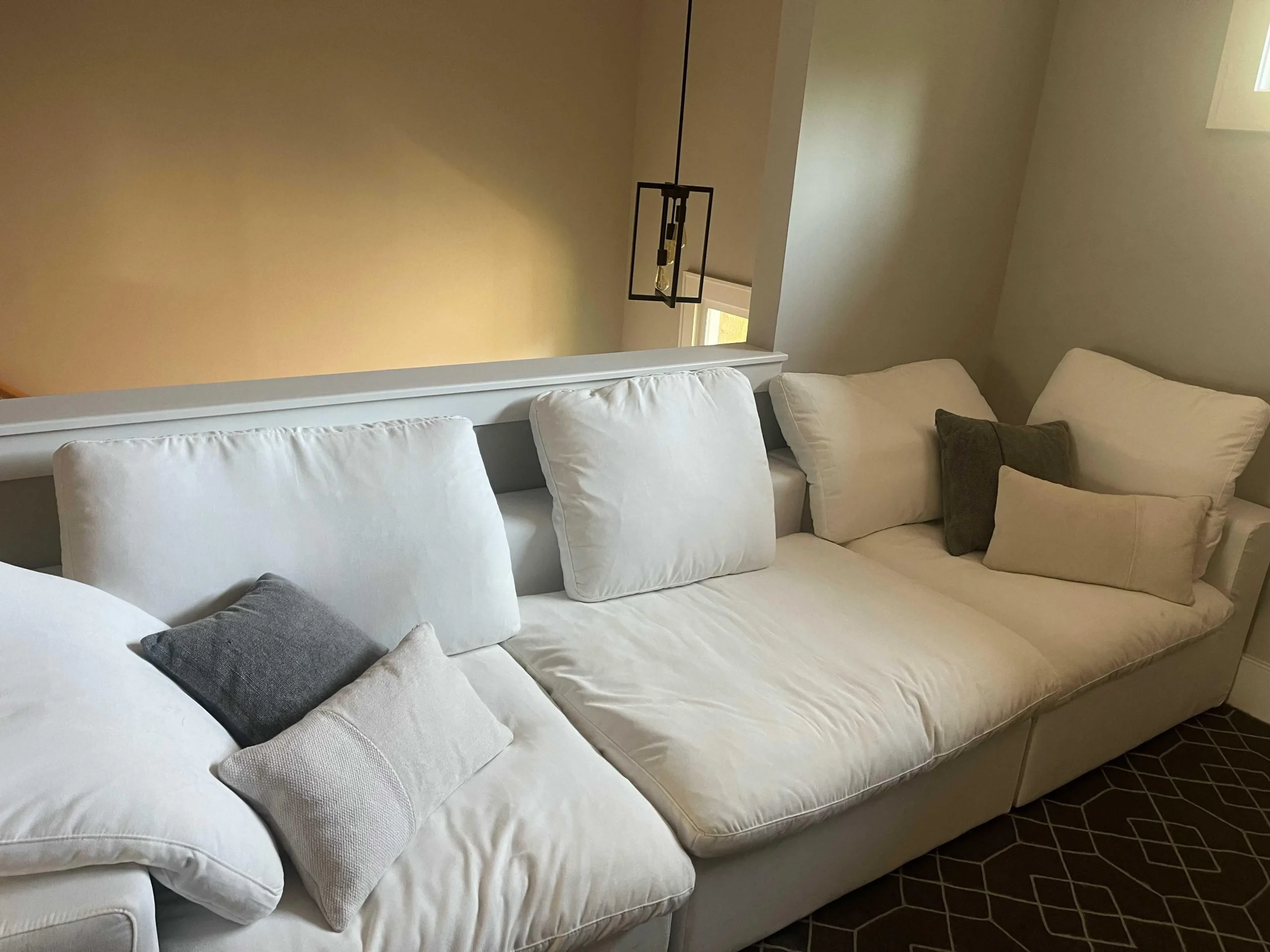How to Choose the Right Size Sofa for Your Room?
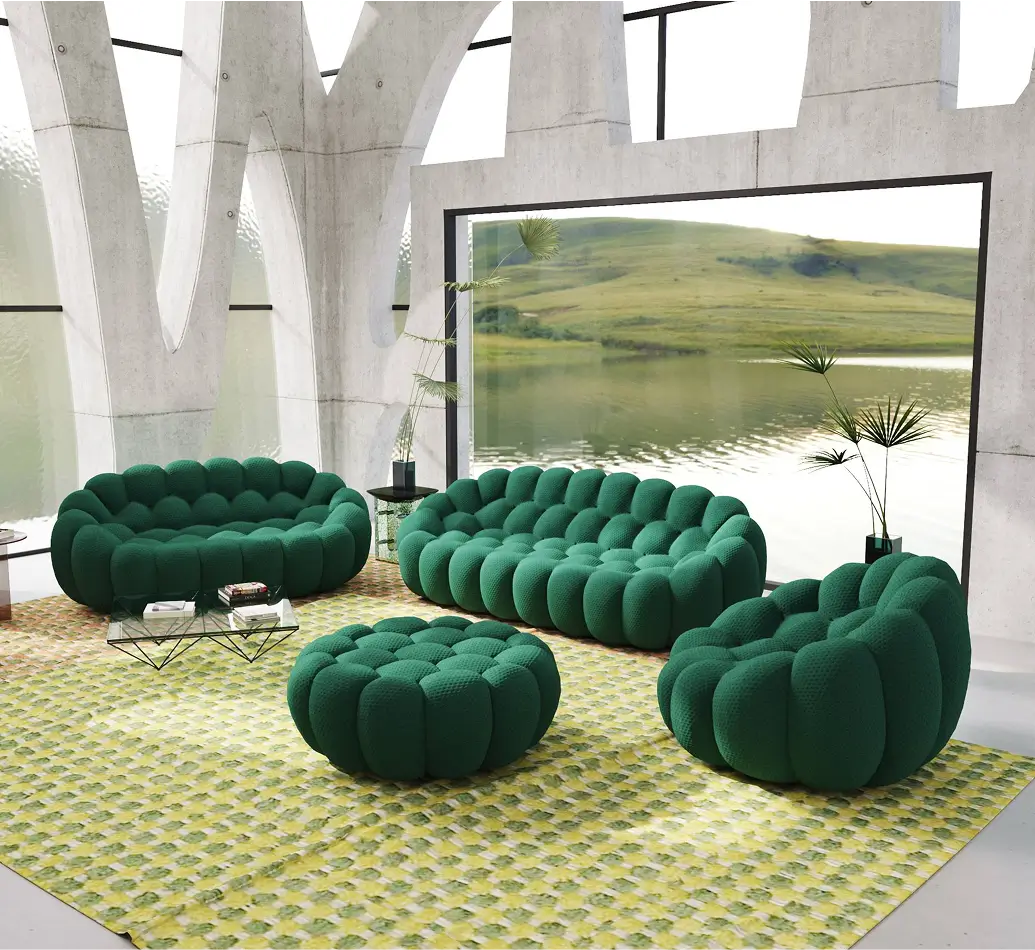
Are you going to buy a new sofa? Maybe you already have your pick. But have you ever considered if the sofa size fits your room? This article will tell you how to choose the right size sofa for your room.
Why is it important to Choose the Right Size Sofa for Your Room?
This is not new: You come across a fancy sofa on the Internet. You love the sofa's look so much and purchase it without hesitation. When the sofa arrives, it turns out that the sofa is too big for the room, or too small for the whole family to sit on it.
Make Your Home Look More Harmonious
If you're considering buying a new sofa, you're probably also thinking about upgrading the look of the room. To give the room a sophisticated look, all elements within the room should look coordinated. Since a sofa is usually one of the largest pieces of furniture in a room, the size of the sofa will have more impact on the overall look and feel of the space. Therefore, it is important to choose a right size sofa based on the dimensions of your room.
Use the Space More Effectively
Besides aesthetics, the size of the sofa also affects the utilization of your living space. A sofa of the wrong size shape can interrupt the traffic flow in your room. Before you decide to buy a sofa, you should consider how the sofa will interact with other furniture and the overall layout of the room. A well-placed sofa can enhance the room's functionality and flow.
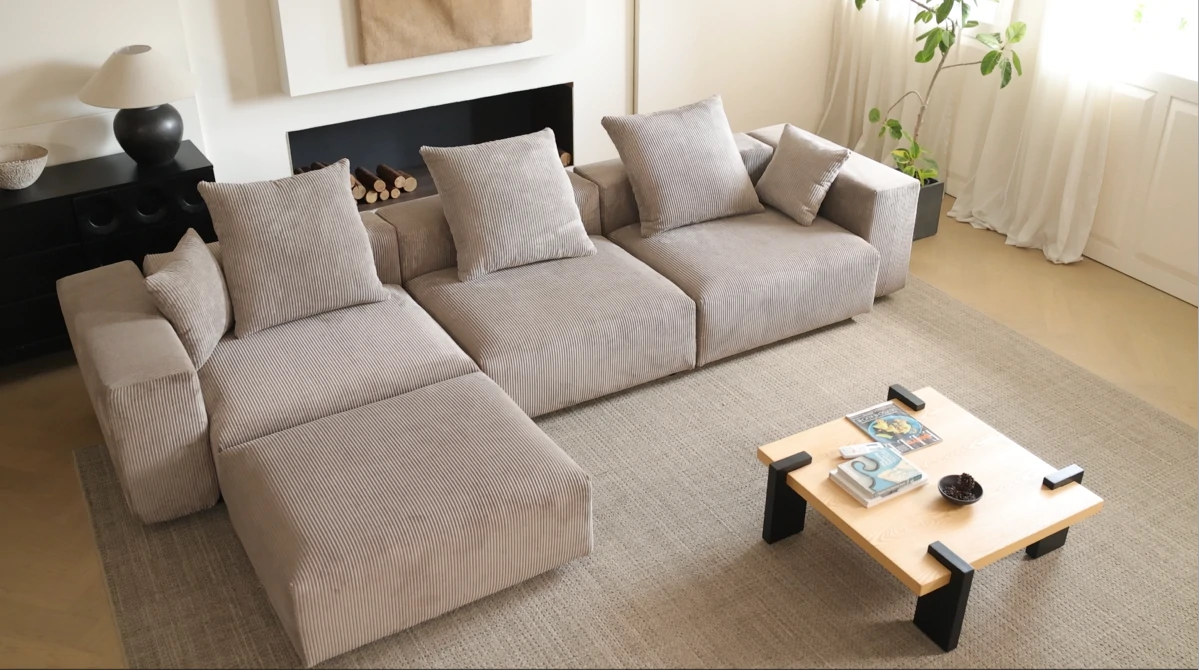
What should you consider before deciding your sofa size?
To choose the right size sofa for your room, you should consider the following things in advance:
In which room will you place the sofa?
The room in which you plan to place the sofa is a critical factor in determining its size. Different rooms have different functions and space constraints. Ask yourself before start measuring for a sofa: Am I placing the sofa in the living room? Or am I placing it in my bedroom? Also, if you are buying a sofa for your apartment, you should consider an apartment-sized sofa.
Where will you place the sofa in the room?
The placement of the sofa within the room is another important aspect to consider. This decision will influence the size and shape of the sofa you choose. Here are some common spots: Focal point, conversation area, and corner.
Also, you need to sure there is enough clearance around the sofa for easy movement. A general rule of thumb is to leave at least 36 inches for walkways.
Who will be using the sofa?
The users of the sofa are a significant factor in determining the size and style of the sofa. If you are living in a big family, you'd better pick a wide sectional sofa that can accommodate the whole family. If you are living alone, you may consider a single-seater or a chaise lounge that doesn't take up much space.
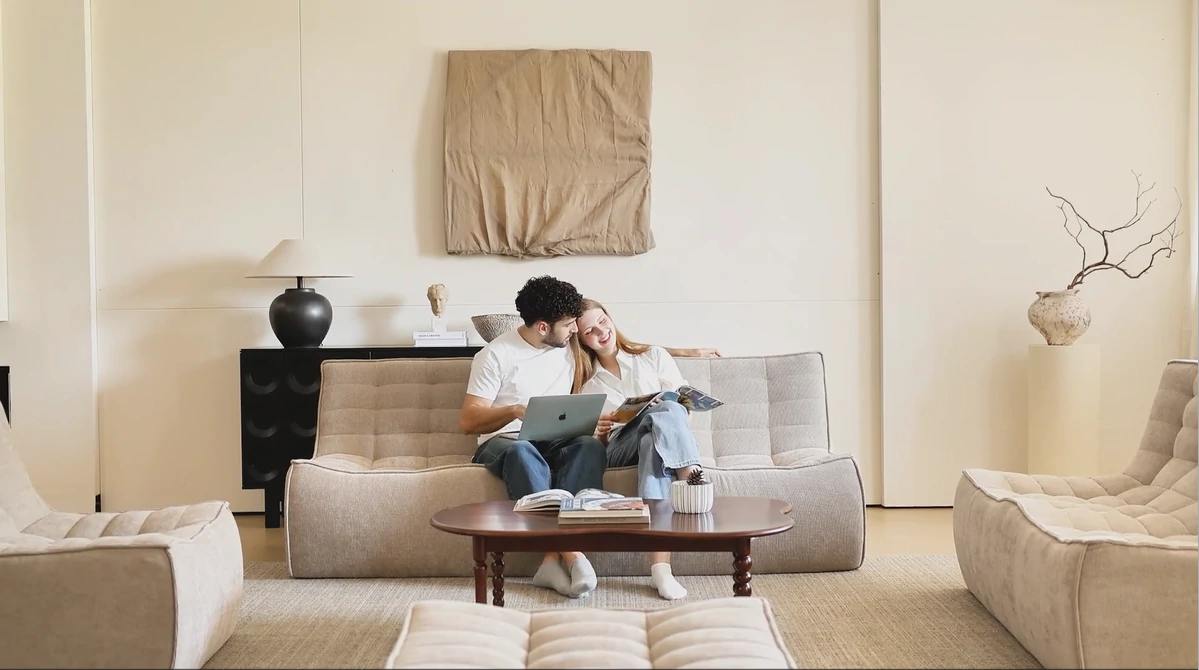
How to Measure the Space for the Sofa?
After confirming where to place the sofa and who will use the sofa, you need to get the specific dimensions of the space for your new sofa.
Prepare the Tools
To measure the space, you will need the following tools:
- A Steel Measuring Tape
- Masking tapes to Mark the Area for Your New Sofa
- Paper and Pen (or a Cell Phone) to Record Numbers
- Tools to ensure measurement accuracy, such as a level.
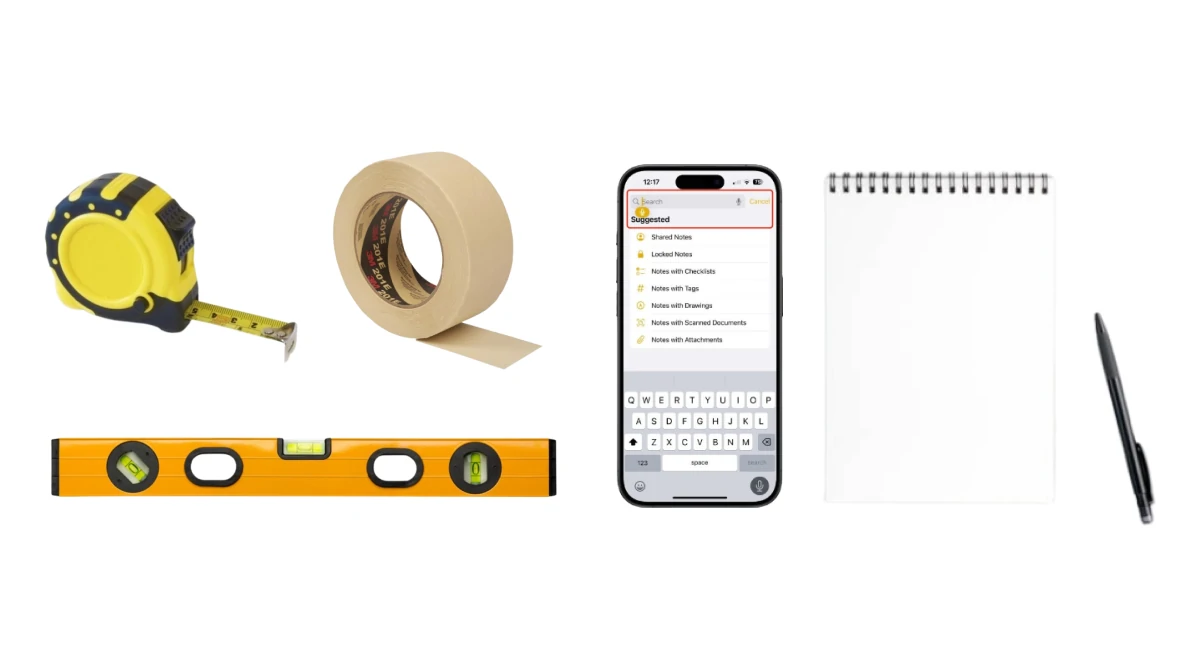
Measure the Space for the Sofa in Steps:
- Measure the width of the background wall behind your new sofa.
- Measure the horizontal distance from the background wall to the doors, windows, and other furniture.
- Make some allowance for a smooth traffic flow in the area you just measured in the last step.
- Measure the ceiling height and the height of the windows.
The width of the background wall will decide the width of your sofa. Typically the sofa width should be about 47.24 inches shorter than the width of the background wall.
This helps you determine the maximum size of the sofa that your room can accommodate.
For a comfortable living experience, you won't want the sofa to take up all the space in your room. Normally, you should spare at least 18 inches of space on either side of the sofa.
The sofa height is often overlooked when people choose a sofa. When choosing a sofa, you should consider the height of its backrest and whether it will obstruct the view in your house.
Measure the Path for the Sofa to Enter Your House
Now you have the dimensions of the area for your new sofa. Congrats! But that's not the end. Don't forget that you also need to ensure the new sofa can successfully get into your house. Follow the steps below to measure the path for the sofa to enter your house.
- Measure the staircase.
- Measure the lift.
- Measure your front door.
- Measure the hallway and internal doors.
If your sofa needs to go up some stairs, measure the staircase at its narrowest point. Remember to take any handrails or light fixtures into account. If this distance is wider than the height of your sofa then it should fit.
If you plan to have the sofa carried by a lift in your building, you will need the dimensions of the lift. Measure the open-door height and width, and the depth of the lift to make sure the sofa can fit inside.
Open your front door as wide as possible and measure the distance between the outer edge of the door to the inner edge of your doorframe at its narrowest point. As long as the width of your front door is bigger than the height of the sofa backrest, the sofa should be able to go into your house.
To make sure your sofa can get into the room that you'd like to place it in, you need to measure the width of any areas that the sofa must pass through, such as hallways and internal doors at their narrowest points. You should also pay attention to all possible obstructions such as radiators, shelving, skirting boards, and lights. As long as the widths of the narrowest points are bigger than the height of your sofa, then the sofa will make it into the room.
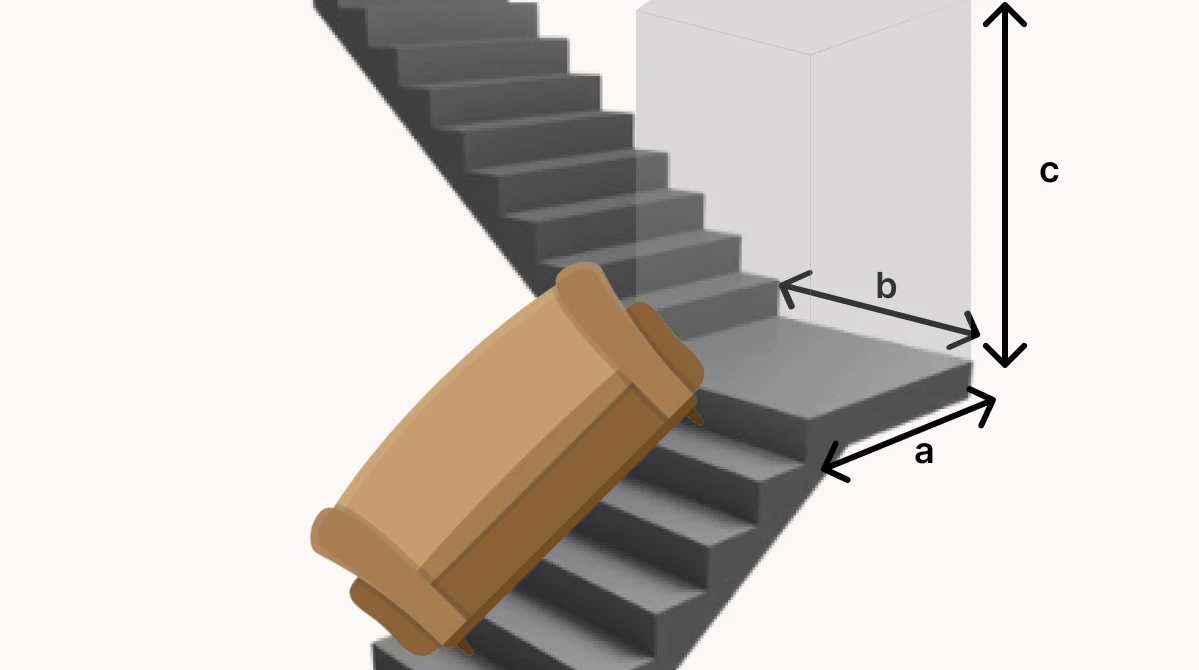
To be noted, some of the sofas can be delivered in separate pieces. If that's the case, you won't need to worry about if the sofa can get through the path to your home. You can contact the customer service of the sofa brand to confirm how the sofa will be delivered.
What Sofa Measurements Should Be considered?
Understand Basic Sofa Dimensions
- Sofa Width: The horizontal measurement from one outer arm to the other outer arm of the sofa.
- Sofa Depth: The measurement from the back of the sofa (the backrest) to the front edge of the sofa (where the seat cushion begins).
- Sofa Height: The vertical measurement from the floor to the top of the sofa.
It's the widest part of the sofa and is crucial when considering how much space the sofa will occupy in a room. The width is important for ensuring that the sofa fits comfortably within the room's layout and that there is enough space for people to move around it.
This dimension is important for comfort, as it determines how far back you can sit and whether you can comfortably stretch out your legs. It also affects the overall look of the sofa in a room, with deeper sofas often appearing more substantial.
The sofa height can impact the visual balance of a room, with taller sofas potentially making a space feel more grand and lower sofas creating a more intimate, cozy atmosphere.
Besides these basic dimensions of the entire sofa, it's also important to know the dimensions of the sofa seat.
- Seat Width: The horizontal measurement of the seating area of a sofa, typically taken from the outer edge of one cushion to the outer edge of the opposite cushion.
- Seat Height: The vertical measurement from the floor to the top of the seat cushion.
- Seat Depth: This measurement is from the front edge of the seat cushion to the back edge of the seat cushion.
This dimension is crucial for determining how much space each person will have when sitting on the sofa and for ensuring that the sofa can comfortably accommodate the intended number of people.
It's an important consideration for comfort and accessibility, especially for those who may have difficulty sitting down or standing up.
Unlike sofa depth, seat depth doesn't include the depth of the backrest. It measures how much seating room you actually have when sitting on the sofa.
In addition, there are also other dimensions like armrest width, arm height, leg height, and so on. Each of these dimensions defines a detail of a sofa. Subtle differences in dimensions can make a sofa significantly different from others. So it's important to read the dimensions in the product description before you purchase a sofa.
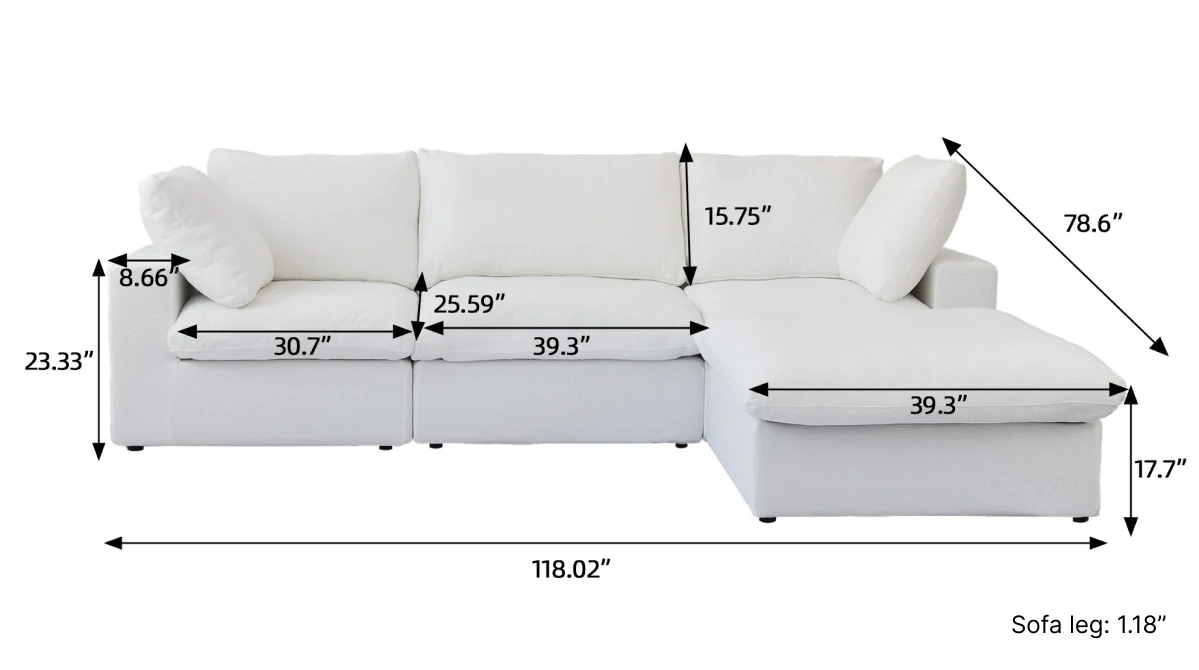
Read the Dimensions in the Product Description
Whether you are buying a sofa online or in-store, you need to know the exact dimensions of the sofa before you pay.
If you are shopping online, you can simply find the dimensions on the product page.
If you are shopping in-store, you can ask the staff about the dimensions. You can also bring your own measuring tape to avoid deviation.
By getting the sofa dimensions, you should always pay attention to the following things: Are you looking at the dimensions of the sofa itself or just the seat? Are the measurement units in imperial or metric? Do the merchants' definitions for a particular dimension align with your understanding?
What's the Best Ratio of the Sofa to Room Size?
The ratio of the sofa to room size will affect two things: Aesthetics and practicality. In other words, to choose the right size sofa for your room, you should take these two factors into consideration.
The Ideal Ratio of the Sofa to Room Size
In the realm of interior design, a design rule called the 2:3 rule is widely accepted. It suggests that your sofa should be the equivalent of ⅔ the size of your room. This rule is designed to avoid choosing furniture that is too big or too small. For instance, if you choose an oversized sectional sofa that fills the whole room, the room will look confined and narrow. Meanwhile, if you buy a 1-seater sofa for a large room, it may seem odd and empty. By following the 2:3 rule, you can keep the room feeling balanced.
There are more similar rules. For example, if you are placing the sofa against a wall, you can simply. If you want to place your sofa in front of a wall, you can subtract 47.24 inches from the width of the wall to determine the width of the sofa you should purchase. This also leaves a visually breathable space, making the entire area appear more balanced and relaxed.
Leave Enough Space for Traffic Flow
When planning a space for your new sofa, you should take a 36- to 42-inch allowance around the sofa for a smooth traffic flow in the room. This also makes your access to drapery or shade hardware more easy.
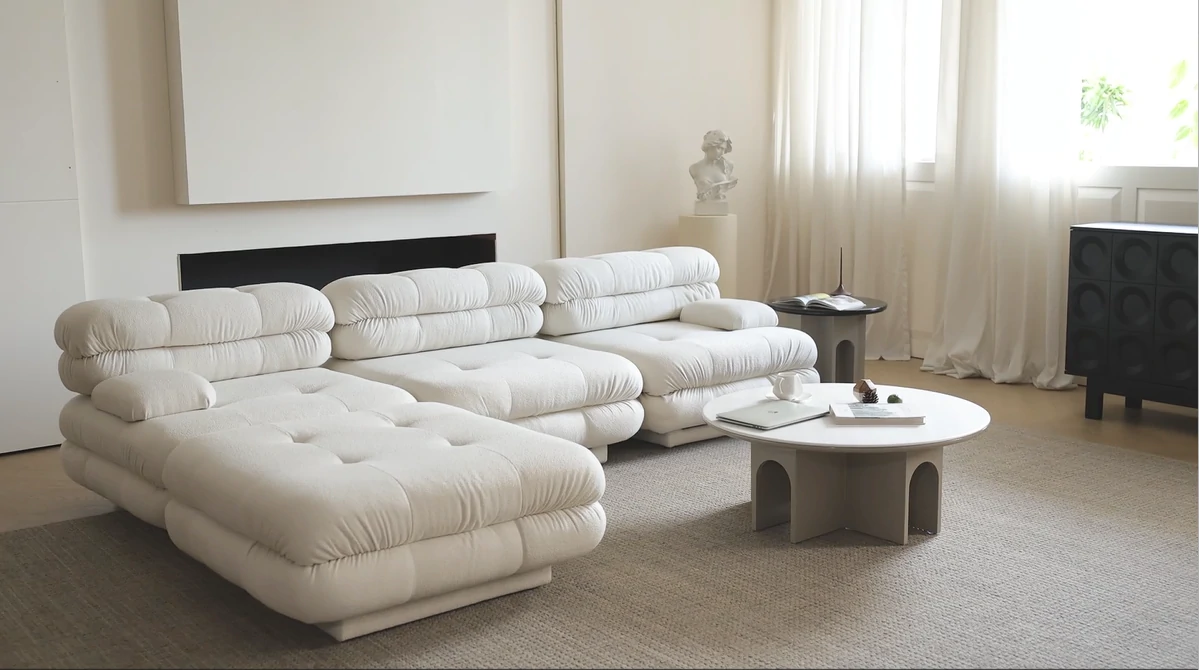
How to Choose the Right Size Sofa Based on Your Living Needs?
A sofa is a piece of furniture, which means it must serve your practical living needs. To make sure that you pick the right size sofa for your room and your daily life, you should do the following things:
Count Your Family Members
Basically, a sofa should be spacious enough to accommodate all your family members. You can consider who usually sits on this sofa and then pick a sofa of the corresponding size accordingly:
Big Family or Guests: If you have a large family or frequently entertain guests, it is suggested that you choose an extra-large sofa or sectional configuration that can accommodate multiple people.
Couple: If it's just you and your partner living in the house, you can pick a 2-seater. Or, if you value personal space and comfort, you can choose a sectional sofa that can be assembled and disassembled easily instead.
Living Alone: If you are living alone, a 1-seater or a comfy chaise lounge that doesn't take up much space would be a good choice.
Take Special Needs into Consideration
If you have kids or pets, you may consider a sofa with more large seat cushions. As they might crawl or jump on the sofa.
If you like taking a power nap on the sofa. You should reserve a room for at least 75 inches seat width and 19.5 inches seat depth for comfortable lounging.
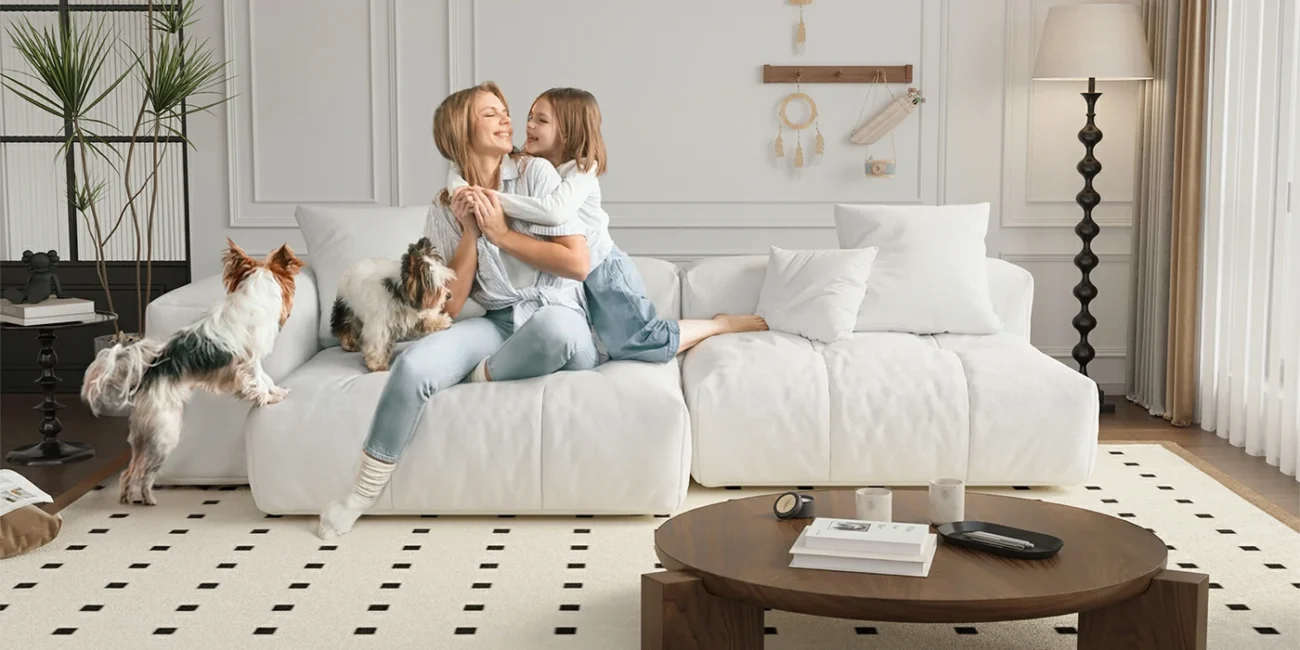
How to Choose the Right Size Sofa by Online Shopping?
Choosing the right size sofa for your room by online shopping can be tricky because not all sellers put the dimensions of a sofa in an obvious spot on the product page. So you need to be ultra-careful when shopping a sofa online.
Read the Product Description
When you come across a sofa in an online store, you may get lost in the fancy pictures of the sofa. But don't rush. Find the dimensions of the sofa on the product description page first. Usually, you can find this information in a “Dimensions” drop-down menu under the add to cart button. If you can't find it there, scroll down the page to find it in more detailed information. If you still feel uncertain, you can contact customer service for help.
Check the Refund and Returns Policy
Before you buy a sofa online, make sure you have read the refund and returns policy of the product. Even if you have made ample preparations, there's always a chance that the dimensions of the sofa you receive might not meet your expectations.
If you are shopping on an e-commerce platform like Amazon, just simply check the return and refund policy of the platform itself.
If you are shopping on an independent online shop, the entrance to the refund and return policy usually finds itself at the bottom of the online store homepage.
You should pay attention to these points: Is the sofa refundable? Do you need to pay the shipping fee if you return it? How does will it cost?
To be noted: A sofa, especially a sectional sofa, is usually seen as an oversized package due to its size. According to USPS requirements, an oversized package is a package with over 108 inches but not more than 130 inches in combined length and girth. USPS charges an additional $100 oversized fee for this kind of package. So you'd better make sure you are buying the right size sofa to avoid extra cost by returning.
Use AR Tools
Do you want to visualize how a sofa will look in your home more directly? There are many practical third-party tools that use AR technology to project furniture in real time into your home, such as Apple's official RoomPlan.
Of course, these tools have high hardware requirements and may not be accessible to everyone. Alternatively, you can use a more traditional method: use a photo editing software (like Photoshop) or the built-in iOS feature “lift a subject from the photo” to extract the image of the sofa. Then place the sofa image into the photo of the room. That way, you can get a rough idea of how it will look.
Conclusion
In general, to choose the right size of sofa, you need to consider factors like the size of your room, the shape of your space, the traffic flow, and the path for the sofa to enter your home. This is an important yet tricky task. However, if you want to save some time and effort, selecting certain types of sofas can help. For instance, buying modular sofas gives you more freedom and flexibility in planning the layout, while purchasing sofas that come in knock-down parts can spare you the worry about whether the sofa can make it into your home.

